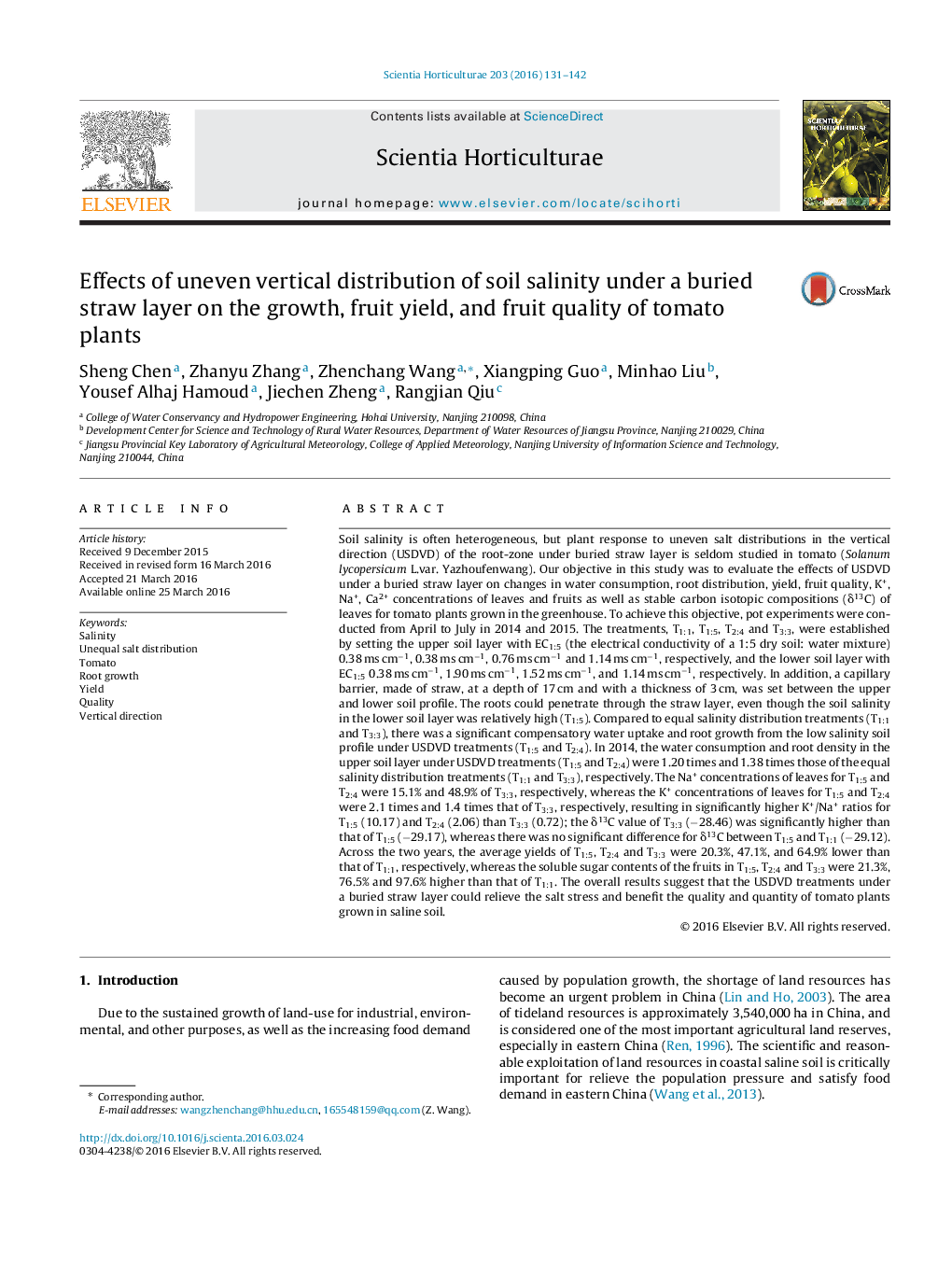| کد مقاله | کد نشریه | سال انتشار | مقاله انگلیسی | نسخه تمام متن |
|---|---|---|---|---|
| 6406321 | 1628795 | 2016 | 12 صفحه PDF | دانلود رایگان |
- Vertical uneven salt distribution in the root-zone decreases Na+ contents in tomato leaves.
- Vertical uneven salt distribution in the root-zone stimulates tomato root growth.
- Vertical uneven salt distribution in the root-zone increases tomato yield.
Soil salinity is often heterogeneous, but plant response to uneven salt distributions in the vertical direction (USDVD) of the root-zone under buried straw layer is seldom studied in tomato (Solanum lycopersicum L.var. Yazhoufenwang). Our objective in this study was to evaluate the effects of USDVD under a buried straw layer on changes in water consumption, root distribution, yield, fruit quality, K+, Na+, Ca2+ concentrations of leaves and fruits as well as stable carbon isotopic compositions (δ13C) of leaves for tomato plants grown in the greenhouse. To achieve this objective, pot experiments were conducted from April to July in 2014 and 2015. The treatments, T1:1, T1:5, T2:4 and T3:3, were established by setting the upper soil layer with EC1:5 (the electrical conductivity of a 1:5 dry soil: water mixture) 0.38 ms cmâ1, 0.38 ms cmâ1, 0.76 ms cmâ1 and 1.14 ms cmâ1, respectively, and the lower soil layer with EC1:5 0.38 ms cmâ1, 1.90 ms cmâ1, 1.52 ms cmâ1, and 1.14 ms cmâ1, respectively. In addition, a capillary barrier, made of straw, at a depth of 17 cm and with a thickness of 3 cm, was set between the upper and lower soil profile. The roots could penetrate through the straw layer, even though the soil salinity in the lower soil layer was relatively high (T1:5). Compared to equal salinity distribution treatments (T1:1 and T3:3), there was a significant compensatory water uptake and root growth from the low salinity soil profile under USDVD treatments (T1:5 and T2:4). In 2014, the water consumption and root density in the upper soil layer under USDVD treatments (T1:5 and T2:4) were 1.20 times and 1.38 times those of the equal salinity distribution treatments (T1:1 and T3:3), respectively. The Na+ concentrations of leaves for T1:5 and T2:4 were 15.1% and 48.9% of T3:3, respectively, whereas the K+ concentrations of leaves for T1:5 and T2:4 were 2.1 times and 1.4 times that of T3:3, respectively, resulting in significantly higher K+/Na+ ratios for T1:5 (10.17) and T2:4 (2.06) than T3:3 (0.72); the δ13C value of T3:3 (â28.46) was significantly higher than that of T1:5 (â29.17), whereas there was no significant difference for δ13C between T1:5 and T1:1 (â29.12). Across the two years, the average yields of T1:5, T2:4 and T3:3 were 20.3%, 47.1%, and 64.9% lower than that of T1:1, respectively, whereas the soluble sugar contents of the fruits in T1:5, T2:4 and T3:3 were 21.3%, 76.5% and 97.6% higher than that of T1:1. The overall results suggest that the USDVD treatments under a buried straw layer could relieve the salt stress and benefit the quality and quantity of tomato plants grown in saline soil.
Journal: Scientia Horticulturae - Volume 203, 12 May 2016, Pages 131-142
